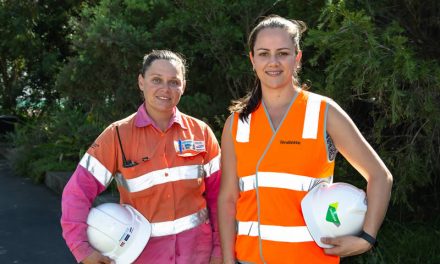A new CAD-based frame and truss software system from the trusted team behind VUETRADE is set to disrupt fabrication and make F&T plants future ready. By Donyale Harrison
The business proposition behind VUETRADE has always been simple: find reliable ways of building better and then share them with the market.
Since 1988, parent company Bellevue Group Australasia has successfully manufactured and supplied materials for timber construction – most famously the VUETRADE range of steel brackets and fasteners – as well as worked to educate builders on which materials are right for various applications.
“It’s a simple paradigm,” says Frank Lourie, VUETRADE’s chief software engineer. “Our CEO told me when I joined the company: we look at what builders need, then improve on what’s available.”

Now, with the launch of VUETRADE Engineered Building Systems (VEBS) and its accompanying Australian-made nailplates and Xaber software, the team is expanding that paradigm into frame and truss fabrication.
“The timber building sector has been well served by the three major nail plate companies,” says Craig Armstrong, VEBS general manager frame and truss. “But building is changing. So, we’ve looked at the way fabrication and supply work now, compared to the way they were 30 years ago.
Rather than adapt what worked well in the past, we decided: let’s reimagine nailplates and design software so they work for the future of timber building construction.” Lourie explains: “The VEBS nailplates themselves are a practical design evolution that is innovative and different. We thought about how people work in F&T plants and we started there, so they’re optimised for the way people actually put frames and trusses together rather than the way you might do it on paper. You can see those differences from the moment you pick them up.
“The Xaber software is similar in that it’s noticeably different to what people are used to, but the beauty is that if, in the future, something that is better than a nailplate or better than the current timber material or whatever comes along, the software is designed from first principles to move with it. We’re not locked into one way of doing things, we can and will do whatever our customers need.”
Armstrong – like the rest of the team – comes from a long background in timber construction. With over 30 years in the timber industry and on the boards of FTMA and the Building Designers Association of Australia, he’s spent most of his career listening to the challenges facing Architects, engineers, fabricators and builders alike.
“Businesses today need to be innovative, lean and agile,” Armstrong says. “So we designed Xaber to be fit for purpose for your business needs now and in the future.
“Having immediate access to information about your business is key. That includes designing the most effective and efficient way to do a particular job, being able to quickly adapt to changes in supply availability, being able to do all your takeoffs – not just our product and timber but all the sheeting flooring fitout and so on – from the building model and then having a live accounting of where your money is at any time; all these are tools that will make life easier, better and more productive for our customers and their customers.”
So how does it work?
 ADAPTABLE SOFTWARE
ADAPTABLE SOFTWARE
Unlike the existing engineering software generally used in the sector, Xaber is based on a CAD platform. All parts of the business are connected through the one software package, rather than needing to integrate data from several separate programs.
CAD is at the heart of every popular design program used by architects, engineers and building designers. The underlying concepts used in Xaber will be of comfort to anyone experienced in the industry including new users familiar or experienced in the use of CAD based systems.
“That’s important,” says Lourie, “because we’re always hearing about the skills shortage, but young people have a lot of skills; we just need to be delivering information in a format they understand.
By way of comparison, for any existing software, extensive training will be required for anyone new to the industry or fresh out of education. However, if you give them a reason to use a program because they’re interested in what it’s showing them, or uses a familiar platform, suddenly you’ve got a workforce that’s invested in upskilling to use those tools.
“The beauty of Xaber is that you can immediately visualise the data. So, whether you’re talking about how people work in factories or you’re coming at it from the technical analysis and accounting side, this is a massive, innovative tool set that can be set up in the most beneficial way that works for you.” Importantly, Xaber is not a one-size-fits-all solution. Instead, it’s tailored to meet each customer’s unique needs via a close relationship with the VEBS team, with the one program capable of being used very differently by different businesses or by different people within the one business. “By building key relationships and understanding what is important to our partners and understanding their needs and frustrations, we can adapt the software to address these issues and improve their process,” says Armstrong.
As Lourie says, “If you’re a business owner who wants to analyse everything to the nth degree, the reports are there for you. If you’re a very meticulous detailer or estimator and you want to get everything 100% correct, all the tools are there. And of course, being CAD, you can immediately open up the drawing from the architect and start working on it. There’s no conversion. You can give it back to the architect or give it to the engineer with no worry about file formats because it’s generic to the system. It’s all transferrable and extensible.”
That ability to seamlessly integrate with other systems is as useful within a fabricator’s plant as it is in communicating with their partners.
“I hear from a lot of people who have issues with turning quotes into production and manoeuvring designs through their facilities,” says Armstrong. “The communication between the software and the machinery in the factories can be cumbersome, especially for smaller family-owned businesses. Xaber makes that world a whole lot simpler, and at the same time it has high-end solutions that will support larger businesses in terms of the level of detail available.
“It allows you to pull up a design that is more than millimetre perfect and then walk through it using a 3D viewer. You can look at the wall frames, trusses, lintels, doorways, the whole lot, and see all of the connections and spot any that could be improved or may create conflicts later.”
Fabricators can share these ‘virtual jobs’ with builders and clients, allowing everyone to sign off with confidence on all parts of the design before it’s built.
“And it’s not just about having the best services placement,” Armstrong adds. “In my time with FTMA, we worked alongside the Board on lowering risk and identifying the dangerous things we do on construction sites that arise out of the way we assemble frames and trusses.
“Xaber lets us look at this and reduce risk prior to manufacturing.”
It’s not just a theoretical claim: VEBS and Xaber have been rigorously tested by independent external engineers, fabricators and detailers.

Above: Familiar CAD based functionality makes it easy to navigate though the Xaber software when creating the design and making changes.
“As an example, we can identify projects where we would show significant savings or manufacturing efficiencies or installation benefits,” says Armstrong, “just by choosing a different way to frame a roof; these changes identify cost savings on site in terms of assembly. Our 3D modelling will show a better way to assemble, with less bracing and fewer one-off trusses being up on site before the rest could be quickly put together. This will improve assembly times, improve safety; it’s a smarter, safer way of installation and improves labour costs.”
Like existing design software, Xaber allows for materials to be turned off and on as available and is rigorous in ensuring atypical materials are fit for an application. “It’s a little simpler to use than its competitors,” Armstrong says, “but the real difference is at a deeper level. Because it’s a CAD-based solution, customers can do all of their other timber takeoff options within the software.
They can measure sheeting boards, architraves and more. All those other elements can be added into the software and quantified in the form of a quoting system.
“For customers who are selling material as well as fabricating, this gives them the advantage of being a lot more accurate with their quotes, giving their customers a clearer picture and more accurate costings.
“And for all our customers, Xaber lets them understand their true costs of goods sold pretty much immediately. We’ve found that this can be a challenge and Xaber facilitates a clear understanding and control of costs at any point in time. A true understanding of live manufacturing costs allows for informed decisions to be made and expensive mistakes to be avoided.”
FUTURE READY
We know the building industry has been going though challenging time – building in 2024 isn’t what it was in 2021 and it’s hard to predict what it will be in 2027. But that’s a situation where the VEBS team sees opportunity for improvement in timber construction.
“Our intention is to challenge the industry through bodies like the FTMA, the Building











